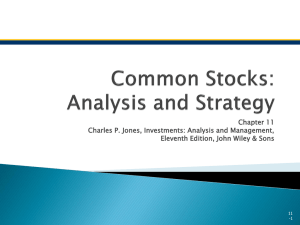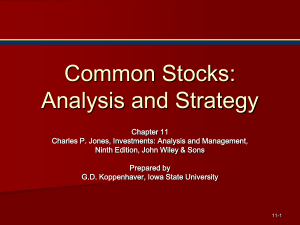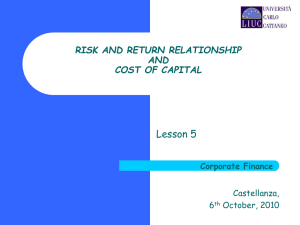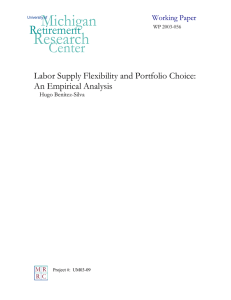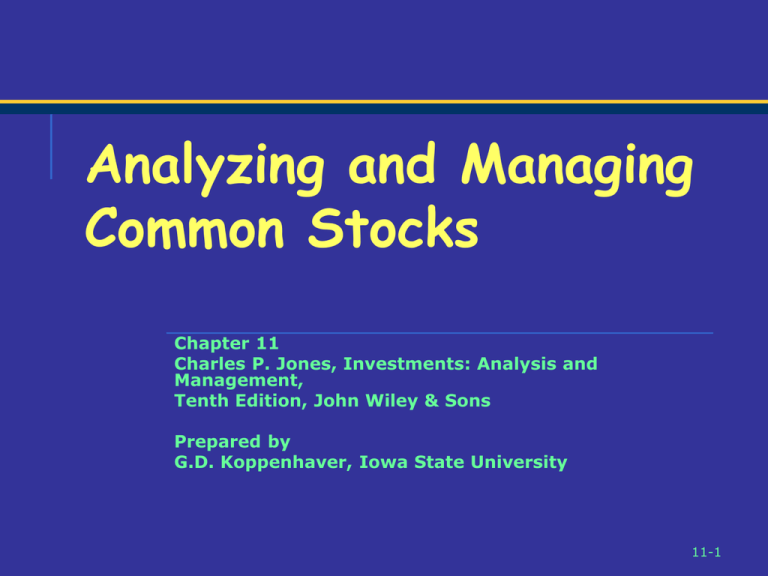
Analyzing and Managing
Common Stocks
Chapter 11
Charles P. Jones, Investments: Analysis and
Management,
Tenth Edition, John Wiley & Sons
Prepared by
G.D. Koppenhaver, Iowa State University
11-1
Impact of the Market
Pervasive and dominant
The single most important risk affecting
the price movement of common stocks
Particularly true for a diversified portfolio of
stocks
Accounts for 90% of the variability in a
diversified portfolio’s return
Investors buying foreign stocks face the
same situation
11-2
Required Rate of Return
Minimum expected rate of return
needed to induce investment
Given risk, a security must offer some
minimum expected return to persuade
purchase
Required RoR = RF + Risk premium
Investors expect the risk free rate as well
as a risk premium to compensate for the
additional risk assumed
11-3
Security Market Line
SML
E(R)
A
kM
B
kRF
C
Beta = 1.0 implies
as risky as market
Securities A and B
are more risky than
the market
Beta >1.0
Security C is less
risky than the
2.0 market
0
0.5
1.0 1.5
BetaM
Beta <1.0
11-4
Understanding the Required
Rate of Return
Risk-free rate
RF =Real RoR +Inflation premium
Real rate of return is basic exchange rate in
the economy
Nominal RF must contain premium for
expected inflation
The risk premium
Reflects all uncertainty in the asset
11-5
Passive Stock Strategies
Natural outcome of a belief in efficient
markets
No active strategy should be able to beat
the market on a risk adjusted basis
Emphasis is on minimizing transaction
costs and time spent in managing the
portfolio
Expected benefits from active trading or
analysis less than the costs
11-6
Passive Stock Strategies
Buy-and-hold strategy
Belief that active management will incur
transaction costs and involve inevitable
mistakes
Important initial selection needs to be made
Functions to perform: reinvesting income
and adjusting to changes in risk tolerance
11-7
Passive Stock Strategies
Index funds
Mutual funds designed to duplicate the
performance of some market index
No attempt made to forecast market
movements and act accordingly
No attempt to select under- or overvalued
securities
Low costs to operate, low turnover
11-8
Active Stock Strategies
Assumes the investor possesses some
advantage relative to other market
participants
Most investors favor this approach despite
evidence about efficient markets
Identification of individual stocks as
offering superior return-risk tradeoff
Selections part of a diversified portfolio
11-9
Active Stock Strategies
Majority of investment advice geared to
selection of stocks
Value Line Investment Survey
Security analyst’s job is to forecast
stock returns
Estimates provided by analysts
expected change in earnings per share, expected
return on equity, and industry outlook
Recommendations: Buy, Hold, or Sell
11-10
Sector Rotation
Similar to stock selection, involves
shifting sector weights in the portfolio
Benefit from sectors expected to perform
relatively well and de-emphasize sectors
expected to perform poorly
Four broad sectors:
Interest-sensitive stocks, consumer durable
stocks, capital goods stocks, and defensive
stocks
11-11
Market Timing
Market timers attempt to earn excess
returns by varying the percentage of
portfolio assets in equity securities
Increase portfolio beta when the market is
expected to rise
Success depends on the amount of
brokerage commissions and taxes paid
Can investors regularly time the market to
provide positive risk-adjusted returns?
11-12
Efficient Markets and
Active Strategies
If EMH true:
Active strategies are unlikely to be
successful over time after all costs
If markets efficient, prices reflect fair
economic value
EMH Proponents argue that little time
should be devoted to security analysis
Time spent on reducing taxes, costs and
maintaining chosen portfolio risk
11-13
Copyright 2006 John Wiley & Sons, Inc. All rights
reserved. Reproduction or translation of this work
beyond that permitted in Section 117 of the 1976 United
states Copyright Act without the express written
permission of the copyright owner is unlawful. Request
for further information should be addressed to the
Permissions department, John Wiley & Sons, Inc. The
purchaser may make back-up copies for his/her own use
only and not for distribution or resale. The Publisher
assumes no responsibility for errors, omissions, or
damages, caused by the use of these programs or from
the use of the information contained herein.
11-14



